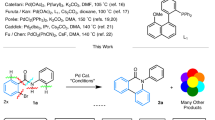Summary
It is proposed in this paper that enzymes, by virtue of a number of correctly positioned sites of interaction with substrates, can force the compression of hydrogen bonds, increasing the probability of proton transfer by quantum mechanical tunneling. By such a catalytic mechanism a rate enhancement of many orders of magnitude may be obtained with a very low energy input requirement. The mechanism would, however, require a highly structured catalyst.
Pertinent aspects of hydrogen bond theory and of tunneling theory are briefly reviewed.
Similar content being viewed by others
References
Adam, W., A. Grimison, R. Hoffman andC. Z. DeOrtiz (1968). Hydrogen Bonding in Pyridine.-J. Am. Chem. Soc.90, 1509–1516.
Allison, W. S., M. J. Connors, andD. J. Parker (1969). Evidence for Direct Hydrogen Transfer During Glyceraldehyde-3-Phosphate Dehydrogenase Catalysis.-Biochem. Biophys. Res. Comm.34, 503–510.
Atkinson, D. E. (1966). Regulation of Enzyme Activity.-Ann. Rev. Biochem.35, 85–124.
Bell, R. P. (1959). The Proton in Chemistry (Cornell Univ. Press, Ithaca), pp. 223.
Boyer, P. D., H. Lardy andK. Myrback (1959). The Enzymes,2nd ed., Vol. I (Academic Press, New York) pp. 785.
Bratoz, S. (1967). Electronic Theories of Hydrogen Bonding.-Adv. in Quantum Chem.3, 209–236.
Brickmann, J. andH. Zimmermann (1966). Über den Tunneleffekt des Protons im Doppelminimumpotential von Wasserstoffbrückenbindungen. 2. Mitteilung: Mittlere Tunnelfrequenzen in der Brückenbindung des Imidazols.-Berichte Bunsengesel.70, 521–524.
Bruice, T. C. andS. Benkovic (1966). Bioorganic Mechanisms, Vol. I and II (Benjamin, New York) pp. 362 and pp. 419.
Caldin, E. F. andM. Kasparian (1965). Quantum-Mechanical Tunnelling and the Dimensions of Energy-Barriers in Proton-Transfer Reactions in Solution.-Disc. Farad. Soc.39, 25–35.
Citri, N. andN. Zyk (1967). Determination of a Constant for a Specific Conformational Transition.-Biochem. Biophys. Res. Comm.26, 216–219.
Coulson, C. A. (1959). The Hydrogen Bond.—in Hydrogen Bonding, ed. D. Hadži, (Pergamon Press, New York), 339–360.
Dixon, M. andE. C. Webb (1964). Enzymes,2nd ed. (Academic Press, New York) pp. 950.
Eigen, M. andL. De Maeyer (1958). Self-Dissociation and Protonic Charge Transport in Water and Ice.-Proc. Roy. Soc.A247, 505–533.
Fischer, S. F. (1967). Collective Excitation of Hydrogen-Bonded Ferroelectrics.-Int. J. of Quantum Chem.1S, 745–753.
French, T. C. andG. G. Hammes (1965). Relaxation Spectra of Ribonuclease. II. Isomerization of Ribonuclease at Neutral pH Values.-J. Am. Chem. Soc.87, 4669–4673.
Glasstone, S., K. J. Laidler andH. Eyring (1941). The Theory of Rate Processes (McGraw-Hill, New York) pp. 611.
Glick, D. M. (1968). Ligand-Induced pK Changes in Chymotrypsin.-Biochemistry7, 3391–3396.
Gould, E. S. (1959). Mechanism and Structure in Organic Chemistry (Holt, Rinehart and Winston, New York) pp. 787.
Hadži, D. (1957). Hydrogen Bonding (Pergamon Press, New York) pp. 565.
Itoh, R. (1967). Proton Transfer in Hydrogen Bond.-J. Phys. Soc. Japan22, 698–709.
Koshland, D. E. (1962). The Comparison of Non-Enzyme and Enzymic Reaction Velocities.-J. Theoret. Biol.2, 75–86.
—, andK. E. Neet (1968). The Catalytic and Regulatory Properties of Enzymes. -Ann. Rev. Biochem.37, 359–410.
Kosower, E. M. (1962). Molecular Biochemistry, (McGraw-Hill, New York) pp. 304.
Lippincott, E. R. andR. Schroeder (1955). One-Dimensional Model of the Hydrogen Bond.-J. Chem. Phys.23, 1099–1106.
Löwdin, P. O. (1965). Quantum Genetics and the Aperiodic Solid. Biological Problems of Heredity, Mutation, Aging and Tumors in View of the Quantum Theory of the DNA Molecule.-Adv. in Quantum Chem.2, 213–360.
Lumry, R. (1959). Some Aspects of the Thermodynamics and Mechanism of Enzyme Catalysis.—in The Enzymes (ed. A. Boyer, H. Lardy and K. Myrback, Academic Press, New York) p. 157.
Messiah, A. (1961). Quantum Mechanics, Vol. I (Wiley, New York) p. 96.
Murthy, A. S. N. andC. N. R. Rao (1968). Molecular Orbital Treatment of Hydrogen Bonding by the EHT and the CNDO/2 Methods: Water.-Chem. Phys. Let.2, 123–125.
Nordvedt, K. (1968). Low-Temperature Effects of the Tunneling Integral in Hydrogen-Bonded Ferroelectrics.-Phys. Rev.173, 547–552.
Pauling, L. (1960). The Nature of the Chemical Bond, 3rd ed. (Cornell Univ. Press, Ithaca) pp. 644.
Pimentel, G. C. andA. L. McClellan (1960). The Hydrogen Bond (Freeman, San Francisco), pp. 470.
Porter, D. J. T. andH. J. Bright (1969). Location of Hydrogen Transfer Steps in Mechanism of Reduction of L-Amino Acid Oxidase.-Biochem. Biophys. Res. Comm.36, 209–213.
Putkey, E. F. andM. Sundaralingam (1968). Structure of DL-Serine Phosphate Monohydrate: An Intermediate Phosphate Bonding System Exhibiting Very Short Hydrogen Bonds.-Nature219, 616–617.
Rein, R. andF. E. Harris (1965). Studies of Hydrogen-Bonded Systems. III. Potential-Energy Surface, Tunneling, and Tautomeric Equilibria in the N-H ... N and O ... H-N Bonds of the Guanine-Cytosine Base Pair.— J. Chem. Phys.43, 4415–4421.
Ressler, N. (1969). Control of Cellular Processes by the Coupling of Resonant Energy to Hydrogen Transfer Reactions. I. Application to Enzyme Mechanisms.-J. Theoret. Biol.23, 425–440.
Samara, G. (1968). Pressure and Temperature Dependence of the Dielectric Properties of Hydrogen-Bonded Ferroelectrics: LiH3 (SeO3) and LiD3 (SeO3).-Phys. Rev.173, 605–613.
Schroeder, R. andE. R. Lippincott (1957). Potential Function Model of Hydrogen Bonds, II. -J. Phys. Chem.61, 921–928.
Stadtman, E. R. (1966). Allosteric Regulation of Enzyme Activity.-Adv. in Enzymol.28, 41–154.
Swain, C. G. andJ. F. Brown (1952). Concerted Displacement Reactions VIII. Polyfunctional Catalysis.-J. Am. Chem. Soc.74, 2538–2543.
Van Panthaleon van Eck, C. L., H. Mendel andJ. Fahrenfort (1958). A Tentative Interpretation of the Results of Recent X-Ray and Infrared Studies of Liquid Water andH 2 O + D2O Mixtures.-Proc. Roy. Soc.A247, 472–481.
Wang, J. H. (1968). Facilitated Proton Transfer in Enzyme Catalysis.— Science161, 328–334.
Weiss, J. J. (1964). Mechanism of Proton Transfer in Acid-Base Reactions.-J. Chem. Phys.41, 1120–1124.
Wyman, J. (1968). Regulations in Macromolecules as Illustrated by Haemoglobin.-Quart. Rev. Biophys.1, 35–80.
Yano, K., N. Higashi andK. Arima (1969). p-Hydroxybenzoate Hydroxylase: Conformational Changes in Crystals of Holoenzymesvs. Holoenzymesubstrate Complex.-Biochem. Biophys. Res. Comm.34, 1–7.
Author information
Authors and Affiliations
Additional information
Work supported by NIGMS Training Grant No. GM 678-07.
Rights and permissions
About this article
Cite this article
Gold, H.J. Proton tunneling and enzyme catalysis. Acta Biotheor 20, 29–40 (1971). https://doi.org/10.1007/BF01556967
Received:
Issue Date:
DOI: https://doi.org/10.1007/BF01556967




